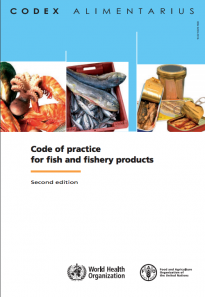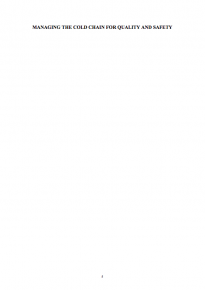Regulatory Environment for Freezer Vessels
The Codex Alimentarius Code of Practice for Fish and Fishery Products is a reference point for the production of frozen fish. As stressed by this Code, the application of appropriate elements of the prerequisite programme and hazard analysis and critical control points (HACCP) principles will provide the processor with reasonable assurance that the essential quality, composition and labelling provisions of the appropriate Codex Standard will be maintained and food safety issues controlled.
Guidance for Food Loss and Waste Control and Freezing
Guidance for Food Loss and Waste Control and Freezing
Some of the guidance related to food loss and waste (FLW) control and freezing includes:
- The fish product should be subjected to a freezing process as quickly as possible because unnecessary delays before freezing will cause temperature of the fish products to rise, increasing the rate of quality deterioration and reducing shelf life owing to the action of micro-organisms and undesirable chemical reactions.
- A time and temperature regime for freezing should be established and should take into consideration the freezing equipment and capacity, the nature of the fish product including thermal conductivity, thickness, shape and temperature and the volume of production to ensure that the range of temperature of maximum crystallization is passed through as quickly as possible.
- The thickness, shape and temperature of fish product entering the freezing process should be as uniform as possible.
- Processing facility production should be geared to the capacity of freezers.
- Frozen product should be moved to the cold storage facility as quickly as possible.
- The core temperature of the frozen fish should be monitored regularly for completeness of the freezing process.
- Frequent checks should be made to ensure correct operation of freezing.
- Accurate records of all freezing operations should be kept.
- For killing parasites harmful to human health, the freezing temperature and monitoring of duration of freezing should be combined with good inventory control to ensure sufficient cold treatment.
- Glazing is considered complete when the entire surface of the frozen fish product is covered with a suitable protective coating of ice and should be free of exposed areas where dehydration (freezer burn) can occur.
- If additives are used in the water for glazing, care should be taken to ensure its proper proportion and application with product specifications.
- Where the labelling of a product is concerned, information on the amount or proportion of glaze applied to a product or a production run should be kept and used in the determination of the net weight, which is exclusive of the glaze.
- Where appropriate, monitoring should ensure that spray nozzles do not become blocked.
- Where dips are used for glazing, it is important to replace the glazing solution periodically to minimize the bacterial load and build-up of fish protein, which can hamper freezing performance.
The Codex standard for quick frozen finfish, uneviscerated and eviscerated provides further guidance on requirements which will help minimize FLW.
Key Publications
Code of Practice for Fish and Fishery Products Codes of practice and guidelines designed to help meet standards and comply with legislation (e.g the Codex Alimentarius Code of Practice for Fish and Fishery Products). | |
Managing The Cold Chain For Quality And Safety This manual summarises the key recommendations for processing, handling, distribution and storage of chilled and frozen foods. |
More Resources
More Resources
31 October 2023
01 October 2023













